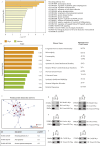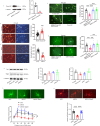Cortex-Specific Tmem169 Deficiency Induces Defects in Cortical Neuron Development and Autism-Like Behaviors in Mice
- PMID: 39779369
- PMCID: PMC11867004
- DOI: 10.1523/JNEUROSCI.1072-24.2024
Cortex-Specific Tmem169 Deficiency Induces Defects in Cortical Neuron Development and Autism-Like Behaviors in Mice
Abstract
The development of the nervous system is a complex process, with many challenging scientific questions yet to be resolved. Disruptions in brain development are strongly associated with neurodevelopmental disorders, such as intellectual disability and autism. While the genetic basis of autism is well established, the precise pathological mechanisms remain unclear. Variations on chromosome 2q have been linked to autism, yet the specific genes responsible for the disorder have not been identified. This study investigates the role of the transmembrane protein 169 (TMEM169) gene, located on human chromosome 2q35, which has not been previously characterized. Our findings indicate that Tmem169 is highly expressed in the nervous system, and its deletion in the male mouse dorsal forebrain results in neuronal morphological abnormalities and synaptic dysfunction. Notably, Tmem169-deficient mice, irrespective of sex, display behavioral traits resembling those observed in individuals with autism. These results suggest that Tmem169 interacts with several key neuronal proteins, many of which are implicated in neurodevelopmental diseases. Furthermore, we demonstrate that Tmem169 promotes neuronal process and synapse development through its interaction with Shank3.
Keywords: Shank3; Tmem169; autism; brain development; neurodevelopmental disease.
Copyright © 2025 the authors.
Conflict of interest statement
The authors declare no competing financial interests.
Figures






Similar articles
-
Prescription of Controlled Substances: Benefits and Risks.2025 Jul 6. In: StatPearls [Internet]. Treasure Island (FL): StatPearls Publishing; 2025 Jan–. 2025 Jul 6. In: StatPearls [Internet]. Treasure Island (FL): StatPearls Publishing; 2025 Jan–. PMID: 30726003 Free Books & Documents.
-
Differently different?: A commentary on the emerging social cognitive neuroscience of female autism.Biol Sex Differ. 2024 Jun 13;15(1):49. doi: 10.1186/s13293-024-00621-3. Biol Sex Differ. 2024. PMID: 38872228 Free PMC article. Review.
-
Short-Term Memory Impairment.2024 Jun 8. In: StatPearls [Internet]. Treasure Island (FL): StatPearls Publishing; 2025 Jan–. 2024 Jun 8. In: StatPearls [Internet]. Treasure Island (FL): StatPearls Publishing; 2025 Jan–. PMID: 31424720 Free Books & Documents.
-
Ash1l loss-of-function results in structural birth defects and altered cortical development.Brain. 2025 Jan 7;148(1):55-68. doi: 10.1093/brain/awae218. Brain. 2025. PMID: 38943682 Free PMC article.
-
The Lived Experience of Autistic Adults in Employment: A Systematic Search and Synthesis.Autism Adulthood. 2024 Dec 2;6(4):495-509. doi: 10.1089/aut.2022.0114. eCollection 2024 Dec. Autism Adulthood. 2024. PMID: 40018061 Review.
References
-
- Adhya D, et al. (2018) Atypical neurogenesis and excitatory-inhibitory progenitor generation in induced pluripotent stem cell (iPSC) from autistic individuals. bioRxiv, 349415.
MeSH terms
Substances
LinkOut - more resources
Full Text Sources
Molecular Biology Databases
